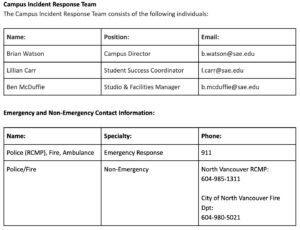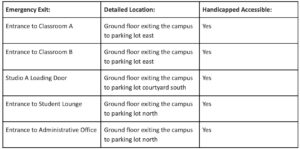WELLNESS, HEALTH, AND SAFETY ACTION PLAN
Introduction
The SAE Institute Vancouver Wellness, Health, and Safety (WHS) Action Plan, also known as the Critical Incident and Crisis Management Policy, includes responses for weather-based events, fire and incendiary-based events, water-based events, events that pose a danger to students on or near campus, campus intrusion, medical emergencies, physical threats, and acts of violence. The WHS Action Plan policy is available to everyone within the SAE Vancouver Student Handbook, which is also on the school website. Students may also request a copy from the Campus Director. Each member of the Campus Incident Response Team will have a copy of this document in their office for quick reference.
The Campus Incident Response Team will train all staff, faculty and students on the WHS Action plan and will also test the policy through scenario events and document the results.

Campus Processes for Responding to Wellness, Health, and Safety Threats
- Communication Process
The Campus Incident Response Team will employ the following process for communication with faculty and staff during a Wellness, Health, and Safety threat:
The Campus Incident Response Team will employ the following process for communication with students during a Wellness, Health, and Safety threat:
- Campus Evacuation Process
When ordered by the Campus Director, the Campus Incident Response Team will employ the following process for evacuating the campus: The Incident Response Team will communicate the evacuation order to all students via a message on Canvas. The evacuation order will be communicated to faculty and staff via text message. Every room on the campus has an Exit Plan, and a map hangs near the room exit. All students, faculty and staff will exit the building according to the Exit Plan for their location. All students, faculty, and staff will proceed to the Assembly Area, which is located at the entrance to the campus parking lot off Harbourside Drive adjacent to the traffic circle. Faculty will conduct a head count at the assembly point to ensure all students are accounted for. Incident response team members, if able to do so safely, will check all rooms to ensure full evacuation.

- Campus Lockdown Procedure
When ordered by the Campus Director, the Campus Incident Response Team will implement the following lockdown procedure:
- The Incident Response Team will notify all students of the lockdown via a message on Canvas.
- Faculty and staff will be notified via text message.
- Upon receiving the lockdown notification:
- Students and faculty will shelter in place.
- A member of the Incident Response Team or faculty will secure all external entrances to the campus.
- Rooms with exterior ground-floor windows must be evacuated.
- If it is safe to do so, the blinds in Classroom A will be drawn closed. Students, faculty, and staff in Classroom A will proceed promptly to Studio A, where they will shelter until further notice.
- If it is safe to do so, the blinds in the Student Lounge will be drawn closed, and Students and faculty in the Student Lounge will proceed to the Administration Office, where they will shelter until further notice.
- Faculty will take attendance and report student headcounts to the Incident Response Team.
- If it is safe to do so, the Incident Response Team will check all rooms to confirm evacuation from areas with potentially vulnerable access points.
- Response to Wellness, Health, and Safety Threats
Weather-based Events
Weather emergencies can pose serious threats to employees and students. Severe weather includes high winds, thunderstorms, lightning storms, hail, tornadoes, hurricanes, extreme heat or cold, excess snow and/or ice and other weather systems that have the potential to create safety hazards or cause property damage.
In the event of a potential weather-based incident:
- The Campus Incident Response Team will monitor local weather conditions and updates, including any advisories, watches, or warnings issued by Environment Canada and other relevant local authorities.
- The Campus Director will provide updates to the Chief Operating Officer/General Manager or the Chief Academic and Compliance Officer, who are members of the SAE Incident Response Team.
- Should the threat to employees, students and property be too great, based on current conditions and forecasts, the campus will be closed until the threat subsides.
- In the event of a campus closing, the Campus Incident Response Team will employ the campus communication process to notify all employees and students of the closure, as well as the subsequent reopening.
- Should employees and students be on campus at the time of the announced closing, the Campus Director will determine whether it is safe for students and employees to exit the campus.
- If it is unsafe to have students and employees exit the campus, then they will be directed to an appropriate shelter area capable of providing protection from the severe weather.
- An appropriate shelter area should have the following characteristics:
- Be located in an interior room of a hardened structure (e.g. conference room, classroom, hallway, bathroom, or office).
- Be free of windows and other glass structures.
- Fire and Incendiary-based Events
In the event of a fire or incendiary incident:
- Make sure that at least one member of the Campus Incident Response Team is made aware of the situation.
- Activate the nearest fire alarm pull station.
- Call 911 from a safe location.
- Prepare to give the following information:
- Exact location of the fire (campus, building address, building name)
- Location of the fire or smoke within the facility
- Cause of fire (if known)
- Number and type of injuries (if known)
- Your name
- Any other information that you think would be beneficial •
- If you are confident you can control the fire with a portable fire extinguisher and have been properly trained in the use of portable fire extinguishers, you may attempt to extinguish the fire if safety permits.
- Evacuate the building as quickly as possible, using the evacuation process.
- For larger fires, evacuate and close doors as you leave to confine the fire as much as possible.
- If clothing catches fire, STOP…..DROP…..ROLL.
- Do not allow the fire to come between you and the exit.
- Follow the evacuation protocol located in each room on campus to find the nearest and safest exit.
- Proceed to the Assembly Area located at the entrance to the campus parking lot off Harbourside Drive adjacent to the traffic circle. and You should verbally warn others to evacuate the building as you exit the building.
- Direct students and visitors to the Assembly Area, if possible.
- Do NOT re-enter the building until authorized by the Campus Director or emergency response personnel.
- Water-based Events
Flooding is a natural feature of the climate, topography, and hydrology of the area surrounding the campus. Long periods of rainfall and mild temperatures are normally the cause of flooding. Flooding may also occur if a water pipe breaks or prolonged rainfall causes urban waterways to rise. Flooding may also occur as a result of damage to water distribution systems, such as the failure of a dam or levee.
Should the campus be subject to flooding:
- The Campus Incident Response Team will identify the cause of the flooding and monitor the situation.
- The Campus Director will provide updates to the Chief Operating Officer/General Manager or the Chief Academic and Compliance Officer, who are members of the SAE Incident Response Team.
- Should the threat to employees, students and property be too great, based on current conditions and forecasts, the campus will be closed until the threat subsides.
- In the event of a campus closing, the Campus Incident Response Team will employ the campus communication process to notify all employees and students of the closure, as well as the subsequent reopening.
- Should employees and students be on campus at the time of the announced closing, the Campus Director will determine whether it is safe for students and employees to exit the campus.
- If it is unsafe to have students and employees exit the campus, then they will be directed to an appropriate shelter area capable of providing protection from the severe weather.
- An appropriate shelter area should have the following characteristics:
- Be located in a room as physically distant from the source of the flooding as possible.
- Be located at the highest point possible.
- Events that Pose a Danger to Students on or Near Campus
SAE Institute is exposed to many events both on the campus and in the surrounding community, all of which have the potential for disrupting the school community, causing casualties, and damaging or destroying public or private property. Such events include but are not limited to natural, technological, and human-caused incidents. These events may require an interagency response involving law enforcement and/or emergency services agencies, depending on the size and scope of the incident.
Should an event posing a danger to employees and students occur on or near the campus:
- Make sure that at least one member of the Campus Incident Response Team is made aware of the situation.
- Immediately call or have someone call 911 and report the threat. Specifically, request police and or medical responders as necessary.
- Provide the following information:
- Type of threat
- Building address and exact location of the source of the danger.
- Building address and the exact location of any victims (building, floor, and room number)
- Condition of any victims
- Identity of the victims
- Any other dangerous conditions
- The identity and location of any perpetrator(s)
- Provide first aid and medical assistance as necessary, if trained.
- Follow the instructions of the Emergency Dispatcher.
- Do not move any victims unless they are in immediate danger.
- If the victim is conscious, try to comfort him/her and obtain medical information (i.e. medical problems, medications, etc.). Any medical information will assist medical personnel if the victim loses consciousness.
- Have a member of the Campus Incident Response Team meet the police and/or ambulance at the building entrance or a safe location and direct emergency personnel to the victim.
- Based on the situation, the Campus Director or his/her designee may initiate the evacuation process or the campus lockdown process as necessary.
- Campus Intrusion
A campus intruder is an individual who enters the campus forcibly and/or without permission. The threat level of intruders can range from posing no immediate threat to an active shooter who is actively engaged in killing or attempting to kill people on the campus. Typically, the immediate deployment of law enforcement is required to remove any intruder and mitigate the harm to victims.
Should you encounter a campus intruder:
- If it is safe to do so, make sure that at least one member of the Campus Incident Response Team is made aware of the situation.
- Call 911 from a safe location and provide the following information:
- A description of the intruder and the threat posed.
- The location (or last known location) of the intruder.
- The direction of travel, if known.
- Number of intruders, if more than one.
- Physical description of the intruder.
- Number and types of weapons held by the intruder, if any.
- Number of potential victims at the campus.
- Your location.
In addition, should you be in danger from an armed intruder, you should quickly determine the most reasonable way to protect yourself.
You should:
- RUN: If there is an accessible escape path, attempt to evacuate the premises. This is your best chance of survival. Be sure to:
- Warn individuals from entering an area where the active shooter may be. Have an escape route and plan in mind.
- Evacuate regardless of whether others agree to follow.
- Leave your belongings behind.
- Help others escape, if possible.
- Keep your hands visible and raised above your head.
- Follow the instructions of any police officers.
- Do not attempt to move wounded people.
- HIDE: If safe evacuation is not possible, find a place to hide where the armed intruder is less likely to find you. Your hiding place should:
- Be out of the armed intruder’s view – away from doors/hallways and behind solid objects, if possible. You can sit on the floor, out of common view, away from doorways and windows.
- Provide protection if shots are fired in your direction (i.e. in a room with a closed and locked door).
- Not trap you or restrict your options for movement.
- To prevent an armed intruder from entering your hiding place or hearing you:
- Lock the door.
- Blockade the door with heavy furniture.
- Close, cover, and move away from windows.
- Silence your cell phone (even the vibration setting can give away a hiding position) and turn off any source of noise (televisions, computers, radios, etc.).
- Turn off the lights.
- Remain quiet.
- FIGHT: As an absolute last resort, and only when you feel your life is in imminent danger, attempt to disrupt and/or incapacitate the active shooter:
- Act as aggressively as possible to subdue the shooter.
- Throw items and improvise weapons.
- Yell.
- Commit to your actions. Your life will depend on it.
- Medical Emergencies
If someone requires immediate medical attention:
- Make sure that at least one member of the Campus Incident Response Team is made aware of the situation.
- Immediately call or have someone call 911 and report the emergency. Provide the following information:
- Type of emergency
- Building address and the exact location of the victim (building, floor, and room number)
- Condition of the victim
- Identity of the victim
- Suspected or known cause of the injury or illness
- Any dangerous conditions
- Provide first aid and medical assistance as necessary, if trained.
- Follow the instructions of the Emergency Dispatcher.
- Do not move the victim unless they are in immediate danger.
- If the victim is conscious, try to comfort him/her and obtain medical information (i.e. medical problems, medications, etc.). Any medical information will assist medical personnel if the victim loses consciousness.
- A member of the Campus Incident Response Team shall meet the ambulance at the building entrance or a safe location and direct emergency personnel to the victim.
Physical Threats
If an employee or student is subjected to a physical threat on the campus grounds:
- Make sure that at least one member of the Campus Incident Response Team is made aware of the situation.
- Immediately call or have someone call 911 and report the threat. Specifically, request police and or medical responders as necessary.
- Provide the following information:
- Type of threat
- Building address and the exact location of any victims (building, floor, and room number)
- Condition of any victims
- Identity of the victims
- Any dangerous conditions
- The identity and location of the perpetrator(s)
- Provide first aid and medical assistance as necessary, if trained.
- Follow the instructions of the Emergency Dispatcher.
- Do not move any victims unless they are in immediate danger.
- If the victim is conscious, try to comfort him/her and obtain medical information (i.e. medical problems, medications, etc.). Any medical information will assist medical personnel if the victim loses consciousness.
- Have a member of the Campus Incident Response Team meet the police and/or ambulance at the building entrance or at a safe location and direct emergency personnel to the victim.
- Based on the situation, the Campus Director or his/her designee may initiate the evacuation process or the campus lockdown process as necessary.
- In accordance with WorkSafeBC regulations, all workplace injuries or incidents will be documented and reported as required.
- Acts of Violence
If an act of violence occurs on the campus grounds:
- Make sure that at least one member of the Campus Incident Response Team is made aware of the situation.
- Immediately call or have someone call 911 and report the emergency.
- Specifically, request police and or medical responders as necessary.
- Provide the following information:
- Type of emergency
- Building address and the exact location of the victim (building, floor, and room number)
- Condition of the victim
- Identity of the victim
- Suspected or known cause of the injury or illness
- Any dangerous conditions
- The identity and location of the perpetrator(s)
- Provide first aid and medical assistance as necessary, if trained.
- Follow the instructions of the Emergency Dispatcher.
- Do not move the victim unless they are in immediate danger.
- If the victim is conscious, try to comfort him/her and obtain medical information (i.e. medical problems, medications, etc.). Any medical information will assist medical personnel if the victim loses consciousness.
- Have a member of the Campus Incident Response Team meet the police and/or ambulance at the building entrance or a safe location and direct emergency personnel to the victim.
- Based on the situation, the Campus Director or his/her designee may initiate the evacuation process or the campus lockdown process as necessary.
SEXUAL MISCONDUCT POLICY
SAE Institute values civility, dignity, diversity, education, equality, freedom, honesty, and safety, as described in the Student Conduct, and is firmly committed to maintaining an environment free from sexual harassment, and sexual assault, collectively referred to in this policy as sexual misconduct.
Sexual misconduct jeopardizes the mental, physical, and emotional welfare of our students and employees, as well as the safety of our learning community. This policy provides information on how the school will proceed once it is made aware of sexual misconduct.
For purposes of this policy, sexual misconduct encompasses a range of behaviors that can create a hostile educational environment, including sexual assault and sexual harassment.
This policy applies to sexual misconduct that is committed by an SAE Institute student or employee whenever that sexual misconduct occurs on campus or off-campus in connection with an SAE Institute recognized program or activity or in a manner that may pose an obvious and serious threat of harm to, or that may have the effect of creating a hostile educational environment for any member(s) of the SAE Institute community. This policy also prohibits retaliation in connection with any reports of possible sexual misconduct that are made under this policy.
SAE Institute strongly encourages the prompt reporting of sexual misconduct to the Campus Director or other campus administrator. The report may be made by:
- A person who believes they experienced sexual misconduct (a “Complainant”); or
- A person who has information that sexual misconduct may have been committed by an SAE Institute student or employee.
If the Reporter or Complainant chooses not to participate in SAE Institute’s investigation of the incident, SAE Institute may, as described below, pursue the report without that person’s participation.
SAE Institute also encourages anyone who believes they experienced a sexual assault (or any other crime) to make a report to the local police department. Collection and preservation of evidence relating to the reported sexual assault is essential for law enforcement investigations, so prompt reporting of the incident to law enforcement is especially critical.
Once SAE Institute is put on notice of possible sexual misconduct, the Complainant will be offered appropriate confidential support and other resources. SAE Institute will take
appropriate steps to prevent and/or address retaliatory conduct following a report. If requested, other participants in the process (such as Reporters or witnesses) may also be offered appropriate support services and information.
The Campus Director will determine the most effective method of investigating the concerns raised by the reported sexual misconduct. In all cases, SAE Institute will respond to the report in a prompt, thorough, procedurally fair, and effective manner. Upon receipt of a report, SAE Institute will strive to complete its investigation and notify the Complainant within 14 calendar days. The results of the investigation may include student or employee disciplinary action, up to and including permanent dismissal from SAE Institute. If deemed appropriate, SAE Institute may adjust the schedules of the students involved to ensure a safe learning environment.
SEXUAL ASSAULT EDUCATION
Sexual assault is a term that refers to an unwanted sexual act against or without a person’s consent. This type of assault encompasses more than violent physical incidents—sexual assault refers to any sexual, physical, verbal, or visual act that forces a person against their will to join in unwanted sexual conduct or attention.
Sexual assault affects many lives—both directly and indirectly. It is a crime that spans age, sexual orientation, religion, and gender, and affects people of all socioeconomic backgrounds and education levels. It is estimated that one in five women and one in 71 men in their lifetime in the United States are affected by sexual assault.
There are many short and long-term effects of sexual assault that affect the mind, body, and spirit. Many survivors experience one or more of these effects and they are not mutually exclusive. For example, a physical reaction to trauma such as self-injury can be the result of depression. The physical, mental, and spiritual effects following sexual assault and rape are difficult to cope with. If you or someone you know is experiencing effects from a sexual assault, there are many resources that can assist.
In an emergency situation, always call 911. Emergency situations include a recent threat of violence, a recent act of violence, or if someone’s health is in imminent danger. Below are Crisis Hotlines that are available 24 hours a day
VictimLink BC
1-800-563-0808























